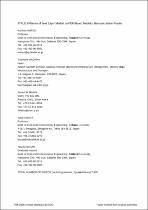 ResearchSpace
ResearchSpace
Influence of seed layer moduli on finite element method-based modulus backcalculation result
JavaScript is disabled for your browser. Some features of this site may not work without it.
- ResearchSpace
- →
- Research Publications/Outputs
- →
- Journal Articles
- →
- View Item
| dc.contributor.author |
Matsui, K

|
|
| dc.contributor.author |
Hachiya, Y

|
|
| dc.contributor.author |
Maina, JW

|
|
| dc.contributor.author |
Kikuta, Y

|
|
| dc.contributor.author |
Nagae, T

|
|
| dc.date.accessioned | 2007-10-16T09:12:02Z | |
| dc.date.available | 2007-10-16T09:12:02Z | |
| dc.date.issued | 2006 | |
| dc.identifier.citation | Matsui, K et al. 2006. Influence of seed layer moduli on finite element method-based modulus backcalculation result. Transportation Research Record, Vol. 1951, pp 122-136 | en |
| dc.identifier.issn | 0361-1981 | |
| dc.identifier.uri | http://hdl.handle.net/10204/1337 | |
| dc.description | Copyright: 2006 National Academy of Sciences | en |
| dc.description.abstract | The determination of pavement layer moduli from falling weight deflec-tometer test data is known as backcalculation analysis. Generally, back-calculation analysis is unstable—greatly influenced by several causes of error. They may be categorized as modeling error in the forward analysis, deflection measurement error, or numerical computation error due to instability in the backcalculation procedure, for example. Because of these problems, the seed values selected for layer moduli greatly influence backcalculation results. To reduce the effects of measurement error, truncated singular-value decomposition is used for regularization. Variable scaling, often used in optimization algorithms, is implemented to improve numerical accuracy. A Ritz vector reduction method is used to solve a large system of dynamic equations in dynamic backcalculation efficiently, and various other means are introduced to decrease computational time. Recent updates of Dynamic Back Analysis for Layer Moduli software, first developed in 1993 and whose solver is based on axi-symmetric finite element method, are presented, as are examples of airfield pavement applications. Results are compared with results from Back Analysis for Layer Moduli static backcalculation software, whose solver was developed using multilayered linear elastic theory. Experience indicates that a dynamic backcalculation is superior to static backcalculation. The results from the two methods are presented and compared. | en |
| dc.language.iso | en | en |
| dc.publisher | National Academy of Sciences | en |
| dc.subject | Backcalculation analysis | en |
| dc.subject | DBALM | en |
| dc.subject | Dynamic back analysis for layer moduli | en |
| dc.subject | APT | en |
| dc.subject | Accelerated pavement testing | en |
| dc.title | Influence of seed layer moduli on finite element method-based modulus backcalculation result | en |
| dc.type | Article | en |
| dc.identifier.apacitation | Matsui, K., Hachiya, Y., Maina, J., Kikuta, Y., & Nagae, T. (2006). Influence of seed layer moduli on finite element method-based modulus backcalculation result. http://hdl.handle.net/10204/1337 | en_ZA |
| dc.identifier.chicagocitation | Matsui, K, Y Hachiya, JW Maina, Y Kikuta, and T Nagae "Influence of seed layer moduli on finite element method-based modulus backcalculation result." (2006) http://hdl.handle.net/10204/1337 | en_ZA |
| dc.identifier.vancouvercitation | Matsui K, Hachiya Y, Maina J, Kikuta Y, Nagae T. Influence of seed layer moduli on finite element method-based modulus backcalculation result. 2006; http://hdl.handle.net/10204/1337. | en_ZA |
| dc.identifier.ris | TY - Article AU - Matsui, K AU - Hachiya, Y AU - Maina, JW AU - Kikuta, Y AU - Nagae, T AB - The determination of pavement layer moduli from falling weight deflec-tometer test data is known as backcalculation analysis. Generally, back-calculation analysis is unstable—greatly influenced by several causes of error. They may be categorized as modeling error in the forward analysis, deflection measurement error, or numerical computation error due to instability in the backcalculation procedure, for example. Because of these problems, the seed values selected for layer moduli greatly influence backcalculation results. To reduce the effects of measurement error, truncated singular-value decomposition is used for regularization. Variable scaling, often used in optimization algorithms, is implemented to improve numerical accuracy. A Ritz vector reduction method is used to solve a large system of dynamic equations in dynamic backcalculation efficiently, and various other means are introduced to decrease computational time. Recent updates of Dynamic Back Analysis for Layer Moduli software, first developed in 1993 and whose solver is based on axi-symmetric finite element method, are presented, as are examples of airfield pavement applications. Results are compared with results from Back Analysis for Layer Moduli static backcalculation software, whose solver was developed using multilayered linear elastic theory. Experience indicates that a dynamic backcalculation is superior to static backcalculation. The results from the two methods are presented and compared. DA - 2006 DB - ResearchSpace DP - CSIR KW - Backcalculation analysis KW - DBALM KW - Dynamic back analysis for layer moduli KW - APT KW - Accelerated pavement testing LK - https://researchspace.csir.co.za PY - 2006 SM - 0361-1981 T1 - Influence of seed layer moduli on finite element method-based modulus backcalculation result TI - Influence of seed layer moduli on finite element method-based modulus backcalculation result UR - http://hdl.handle.net/10204/1337 ER - | en_ZA |





